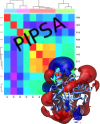

This is based on insertion of a unique protein identifier. Currently a UNIPROT accession code must be given. The workflow depends on an EC annotation in the description line of your UNIPROT entry. Alternatively you can provide the EC annotation together with the UNIPROT accesssion (seperated by a colon). This EC link is used to search in BRENDA and SABIO-RK entries.
In case of unknown or only vaguely known protein functionality ProFAT may assist in detecting protein function and structural homology.
http://cluster-1.mpi-cbg.de/profat/profat.htmlProFAT is a tool for the functional annotation of proteins via the detection of weak homologies. Sequence homology is detected with NCBI's PSI-BLAST system. Structural homology is detected with UCL's Threader software. These results are then combined by the use of GenBank annotation and basic text mining.
ProFAT requires the user to submit a keyword list along with the protein sequence. Several pre-made keyword lists are available, however, the system is used optimally with a user defined keyword list consisting of suspected or experimentally determined information.
Bradshaw C. R., Surendranath V., and Habermann B. BMC Bioinformatics 2006, 7:466